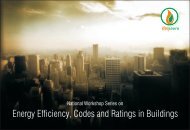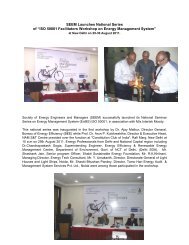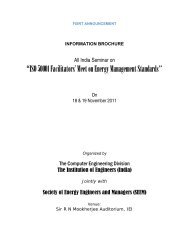Download File
Download File
Download File
You also want an ePaper? Increase the reach of your titles
YUMPU automatically turns print PDFs into web optimized ePapers that Google loves.
POWER METHODOLOGY<br />
CONVENTIONAL ENERGY<br />
NON RENEWABLE<br />
HAZRDOUS FOR ENVIRONMENT ON LONG TERM<br />
NON-CONVENTIONAL ENERGY<br />
RENEWABLE, POLLUTION FREE<br />
AN ALTERNATE SOURCE FOR A BETTER FUTURE<br />
eg. WIND, SOLAR, BIOMASS ETC.
How Wind Turbines Work<br />
<br />
Wind is a form of solar energy. Flow of Winds are caused by<br />
uneven heating of the atmosphere by the sun,<br />
the irregularities of the earth's surface,<br />
rotation of the earth.<br />
Wind flow patterns modified by the earth's terrain, bodies of<br />
water, and vegetation.<br />
Humans use wind flow, or motion energy, for: sailing, flying a<br />
kite, and even generating electricity.
How Wind Turbines Work<br />
The term wind energy or wind power is the<br />
process that the wind is used to generate<br />
mechanical power or electricity.<br />
Wind turbines convert kinetic energy of wind<br />
into mechanical power, which can be used<br />
for specific tasks e.g. grinding grain, pumping<br />
water or convert this mechanical power into<br />
electricity.
How Wind Turbines Work<br />
<br />
How wind turbines make electricity<br />
Simply stated, wind turbine works opposite of fan. Instead of<br />
using electricity to make wind, wind turbines use wind to make<br />
electricity. The wind turns the blades, that spin a shaft, which<br />
connects to a generator and makes electricity.<br />
<br />
Aerial view of a wind power plant shows how a group of wind<br />
turbines can make electricity for the utility grid. The electricity is<br />
sent through transmission and distribution lines to homes,<br />
businesses, schools, and so on.
Ariel View
GRID CONNECTION OF WIND<br />
TURBINE
WIND TURBINE TYPES<br />
Types of Wind Turbines<br />
Modern wind turbines fall into two basic groups<br />
<br />
<br />
the vertical-axis design,<br />
the horizontal-axis design typically<br />
two blades (upwind or downwind)<br />
three blades (upwind)<br />
Horizontal axis turbines are the most common type used<br />
today..
WITH / WITHOUT GEAR<br />
Gear connects low-speed shaft to high-speed shaft to<br />
increase the rotational speeds from about 15 to 50 rpm<br />
to about 1100 to 1550 rpm, the speed required by most<br />
generators to produce electricity. The gear box is a<br />
costly and heavy part of the wind turbine<br />
“Direct Drive” wind turbines operate at lower rotational<br />
speeds and don't need gear boxes
SYNCHRONUS /<br />
ASYNCHRONUS<br />
GENERATORS<br />
Usually asynchronous generator that produces<br />
50-cycle AC electricity because of it’s<br />
robustness and grid friendly<br />
Also synchronous generators are being used in<br />
gearless system<br />
AND Tubular / Lattice towers
FILM BY NITTR, BHOPAL<br />
10 MINUTES FILM<br />
ON<br />
PARTS AND COMPONENTS<br />
OF<br />
WIND TURBINES
Schematic Sketch - WTG
COMPONENTS<br />
Anemometer<br />
Blades<br />
Brake<br />
Controller<br />
Low-speed shaft<br />
Gear box<br />
Generator<br />
High-speed shaft
COMPONENTS<br />
Rotor<br />
Nacelle<br />
Pitch<br />
Tower<br />
Wind direction<br />
Wind vane<br />
Yaw drive<br />
Yaw motor
AREAS REQUIRE ATTENTION<br />
Design specification<br />
Generally designed life 20 years, attention required for<br />
rotating components<br />
materials to be used<br />
design criteria for components<br />
surrounding & ambient condition<br />
service dependability
AREAS REQUIRE ATTENTION<br />
Grid compatibility & interferences<br />
VOLTAGE / FREQUENCY<br />
VOLTAGE & CURRENT ASSYMETRY<br />
HARMONICS ( for power electronics)<br />
VAR DRAWAL ( for inductive components)<br />
GRID FLICKERING<br />
STARTING CURRENT
SUPPLY SYSTEM<br />
POOR GRID QUALITY AFFECTS PROJECT VIABILITY<br />
MEDIUM VOLTAGE SYSTEM (10 - 25 MW)<br />
<br />
HIGH VOLTAGE SYSTEM (ABOVE 15 MW)<br />
NEED OF INDIVIDUAL TRANSFORMER<br />
TO AVOID HIGH LOSSES IN LOW VOLTAGE LINE<br />
LARGE WIND FARMS NEED SEPARATE<br />
SUB STATION
PRESENT WIND POWER<br />
SCENARIO<br />
INSTALLED CAPACITY – WORLD WIDE<br />
MORE THAN 72,600 MW<br />
INSTALLED CAPACITY – INDIA<br />
6500 MW (TILL MARCH 31, 2007)
QUESTIONS PLEASE



![Wind Turbines [Compatibility Mode]](https://img.yumpu.com/50960937/1/184x260/wind-turbines-compatibility-mode.jpg?quality=85)
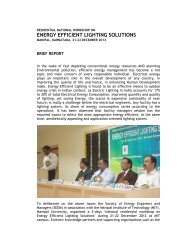
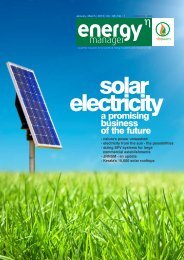
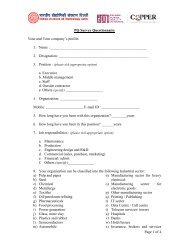
![SEEM1.ppt [Compatibility Mode] - Society of Energy Engineers ...](https://img.yumpu.com/47774742/1/190x143/seem1ppt-compatibility-mode-society-of-energy-engineers-.jpg?quality=85)


